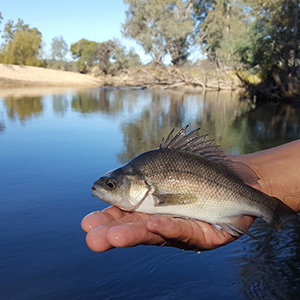Larval fish sensitivity to a simulated cold-water pulse varies between species and age

Accepted: 27 June 2022
Supplementary: 167
HTML: 135
All claims expressed in this article are solely those of the authors and do not necessarily represent those of their affiliated organizations, or those of the publisher, the editors and the reviewers. Any product that may be evaluated in this article or claim that may be made by its manufacturer is not guaranteed or endorsed by the publisher.
Authors
The release of cold-water from hypolimnetic zones of impoundments sharply reduces downstream riverine water temperature. This cold-water pollution (CWP) can extend for hundreds of kilometres, severely challenging the physiological ability of aquatic fauna, particularly ectotherms such as fish, to maintain essential processes such as metabolism, development and growth and survival. The impact of CWP on native fish, especially early life stages, is poorly known. We investigated the effect of a 24-hour exposure to a range of environmentally-related water temperatures (8, 10, 12, 14, 16, 18 and 20°C) on three age-classes (<24-hour-old, 7-day and 14-day-old larvae) of two Australian native fish species: Murray cod (Maccullochella peelii) and Macquarie perch (Macquaria australasica). Overall, larvae of M. peelii were more sensitive to lower water temperatures and hence CWP than M. australasica, indicated by higher rates of equilibrium loss. Larvae of M. peelii were most sensitive to exposure at seven days old whereas M. australasica larvae were most sensitive at <24-h-old. Using our results, we modelled pre- and post-impoundment temperature scenarios and estimated the downstream CWP footprint for both species in an Australian river reach. Larvae of M. peelii were predicted to be absent from the first 26 km of river downstream of the impoundment compared with no impact on the distribution of M. australasica. Managing riverine water temperature below impoundments is fundamental to promoting positive outcomes for endemic fish on not only a local, but global basis. This study emphasises the differential impact of CWP among the critical early life stages and fish species and highlights the urgent need to better manage hypolimnetic water releases to improve downstream river ecosystems.
Edited by
Pietro Volta, CNR-IRSA Verbania, ItalyHow to Cite

This work is licensed under a Creative Commons Attribution-NonCommercial 4.0 International License.
Similar Articles
- Branaavan Sivarajah, Jesse C. Vermaire, John P. Smol, Assessing the potential environmental factors affecting cladoceran assemblage composition in arsenic-contaminated lakes near abandoned silver mines , Journal of Limnology: Vol. 80 No. 2 (2021)
- Shuchun Yao, Bin Xue, Sedimentary geochemical record of human-induced environmental changes in Huanggaihu Lake in the middle reach of the Yangtze River, China , Journal of Limnology: Vol. 74 No. 1 (2015)
- Stefan Sommer, Roberta Piscia, Marina M. Manca, Diego Fontaneto, Arpat Ozgul, Demographic cost and mechanisms of adaptation to environmental stress in resurrected Daphnia , Journal of Limnology: Vol. 75 No. s2 (2016): Lake Orta: a new lease on life
- Javier Alcocer, Ana C. Ruiz-Fernández, Elva Escobar, Libia H. Pérez-Bernal, Luis A. Oseguera, Vilma Ardiles-Gloria, Deposition, burial and sequestration of carbon in an oligotrophic, tropical lake , Journal of Limnology: Vol. 73 No. 2 (2014)
- Tomi P. Luoto, Spatial uniformity in depth optima of midges: evidence from sedimentary archives of shallow Alpine and boreal lakes , Journal of Limnology: Vol. 71 No. 1 (2012)
- Owen Lind, Laura Dávalos-Lind, Carlos López, Martin López, Juli Dyble Bressie, Seasonal morphological variability in an in situ Cyanobacteria monoculture: example from a persistent Cylindrospermopsis bloom in Lake Catemaco, Veracruz, Mexico , Journal of Limnology: Vol. 75 No. s1 (2016): Proceedings of the 6th National Congress of Limnology
- Csaba Vadadi-Fülöp, Levente Hufnagel, Climate change and plankton phenology in freshwater: current trends and future commitments , Journal of Limnology: Vol. 73 No. 1 (2014)
- Giuseppe Garlasché, Giulia Borgomaneiro, Roberta Piscia, Marina Manca, Ester M. Eckert, Diego Fontaneto, Metabarcoding to monitor the crustacean zooplankton of a lake improves when using a reference DNA library from local samples , Journal of Limnology: Vol. 82 (2023)
- Arpana Yadav, Lalit Kumar Pandey, In situ effects of arsenic, aluminium and chromium stresses on algal periphyton of the river Ganga at Varanasi, India , Journal of Limnology: Vol. 82 (2023)
- Amanda Valois, Keith Somers, Chantal Sarrazin-Delay, Wendel (Bill) Keller, Are bioassessments based on the reference condition approach affected by rapid approaches to sample collection and processing? , Journal of Limnology: Vol. 75 No. 2 (2016)
<< < 23 24 25 26 27 28 29 30 31 32 > >>
You may also start an advanced similarity search for this article.
-
John D. Koehn, Charles R. Todd, Henry Wootton, Michael JoyMarine and Freshwater Research : 2023

 https://doi.org/10.4081/jlimnol.2022.2056
https://doi.org/10.4081/jlimnol.2022.2056





